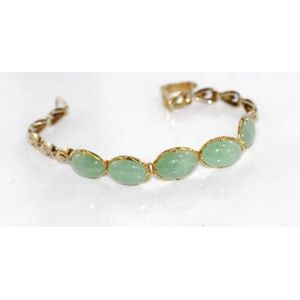Carnelian Art Deco Bracelet
You must be a subscriber, and be logged in to view price and dealer details.
Subscribe Now to view actual auction price for this item
When you subscribe, you have the option of setting the currency in which to display prices to $Au, $US, $NZ or Stg.
- Cabochon Cut in Jewellery - A cabochon cut is a type of gemstone cutting where the stone is cut and polished in a convex shape with a flat bottom and a domed top, with no facets. This type of cut is typically used for opaque or translucent stones that have natural patterns or inclusions that are best displayed in this type of cut. Examples of stones that are often cut as cabochons include turquoise, opal, and moonstone.
- Gilding - Gilding is a method of ornamentation whereby a thin sheet of gold metal is applied to items made of wood, leather, ceramics, glass and silver for decorative purposes.
For furniture including mirrors, the sheet of gold is usually applied over a coating of gesso. Gesso is a mixture of plaster of Paris and gypsum mixed with water and then applied to the carved wooden frames of mirrors and picture frames as a base for applying the gold leaf. After numerous coats of gesso have been applied, allowed to dry and then sanded a coat of "bole", a usually red coloured mixture of clay and glue is brushed on and allowed to dry, after which the gold leaf is applied. Over time parts of the gilding will rub off so the base colour can be seen. In water gilding, this was generally a blue colour, while in oil gilding, the under layer was often yellow. In Victorian times, gilders frequently used red as a pigment beneath the gold leaf.
Metal was often gilded by a process known as fire gilding. Gold mixed with mercury was applied and heated, causing the mercury to evaporate, the long-term effect of which was to kill or disable the craftsman or woman from mercury poisoning. The pursuit of beauty has claimed many victims, not the least of which were the artists who made those pieces so highly sought after today. - Art Deco Period - The Art Deco period was a cultural movement that emerged in the 1920s and 1930s, and was characterized by its emphasis on modernism, luxury, and elegance. The name "Art Deco" comes from the Exposition Internationale des Arts Décoratifs et Industriels Modernes, a large exhibition held in Paris in 1925 that showcased the latest trends in decorative arts.
Art Deco was a reaction against the ornate and elaborate styles of the previous era, and reflected a new modern sensibility. It was characterized by streamlined, geometric shapes, bright colours, and the use of new materials such as chrome, glass, and Bakelite. Art Deco designers sought to create a sense of luxury and sophistication, often incorporating expensive materials such as ivory, marble, and rare woods.
Art Deco had a significant impact on a wide range of artistic fields, including architecture, fashion, graphic design, and interior design. Some of the most iconic examples of Art Deco architecture include the Empire State Building in New York City, the Hoover Building in London, and the Palais de Chaillot in Paris.
The Art Deco period came to an end in the 1940s, as World War II and changing cultural trends led to a shift in artistic styles. However, Art Deco remains an important influence on design and art, and continues to be celebrated for its modernist sensibility and glamorous aesthetic. - Carnelian Glass - Carnelian glass is a type of glass that is colored red, orange, or brownish-red. It is made by adding iron oxide to the glass mixture. The color of carnelian glass can vary depending on the amount of iron oxide that is added, as well as the firing temperature. Carnelian glass is often used to make beads, jewellery, and other decorative items. It can also be used to make stained glass windows and other art objects. Carnelian glass is sometimes called "carnelian chalcedony" or "carnelian quartz."
Carnelian glass was first made in the Roman Empire. It was also made in ancient Egypt, Greece, and Mesopotamia. Carnelian glass was not made again until the Renaissance, when it became popular again. Today, carnelian glass is made in many countries around the world.
This item has been included into following indexes:
Visually similar items

An antique hardstone bracelet, silver set, late 19th century, made as a padlock styled bracelet featuring large oval and carved panels of alternating hardstones, banded agate, bloodstone and white agate, each bezel or drill set, connected by small open ova

A sterling silver Georg Jensen bracelet and earrings, Petal bracelet, 19 cm in length with petal screw fitting earrings. Total weight 42grams, with Georg Jensen box.

Vintage 9ct gold and greenstone earrings

10ct yellow gold and jade bracelet, weight: 10.5 grams, size: 17 cm length, (stamped 18L tested 10ct)
